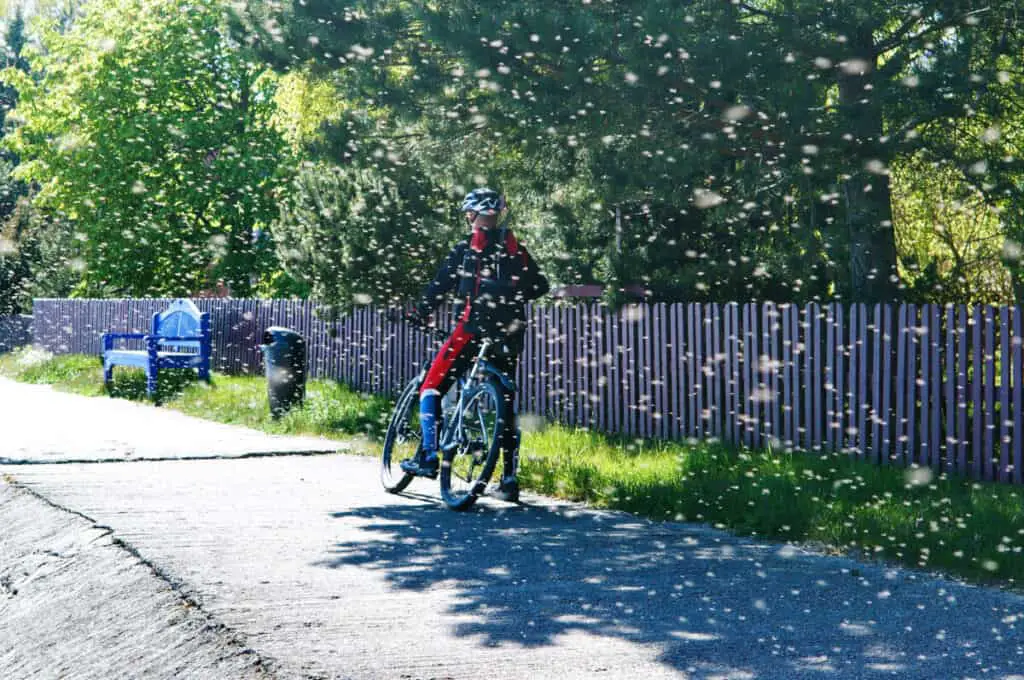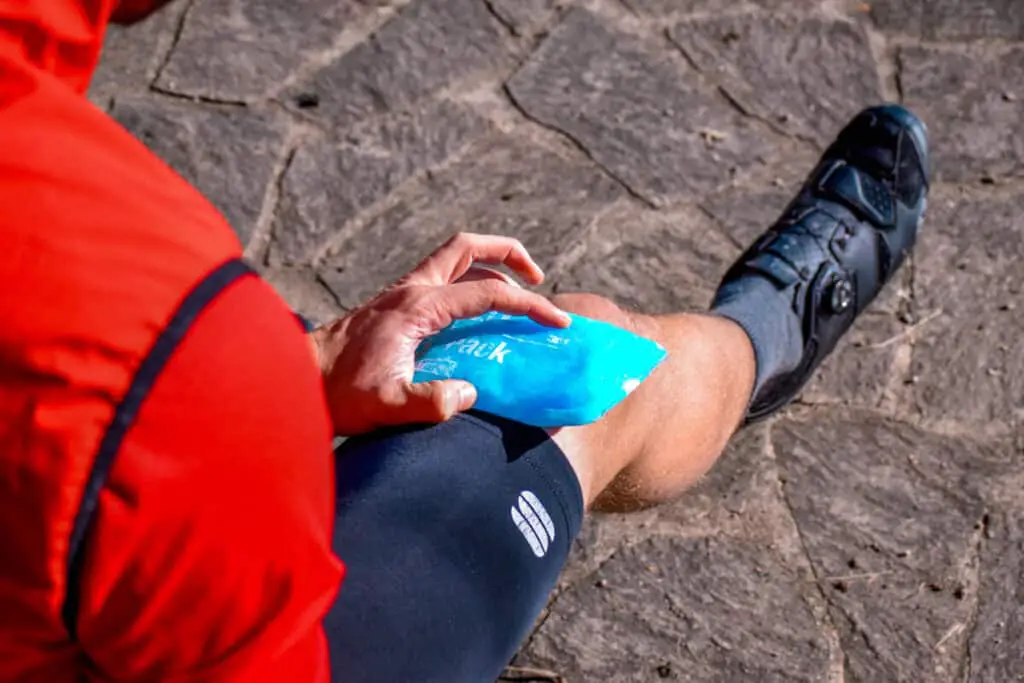Summertime is great for a bike ride. High temperatures with the sun in the sky offer a pleasant experience that is hard to beat in any other season. But as the cyclists come out of their home, so does insects. And when the two collide, it can be uncomfortable and even dangerous for both parties.
Avoid bee stings by wearing a helmet with mesh in the vents, sunglasses and by zipping up the jersey. If stung, remove the stinger and apply ice on the spot. Take antihistamines to reduce the itching. If you’re allergic, see a doctor immediately.
Getting stung on a ride can be unpleasant and, in the worst-case scenario, even deadly experience. It’s important to know how to protect yourself from getting stung and how to react if a bee stings you anyway.
Why do insects attack cyclists?

The insects don’t attack you just for fun. Like most animals, they attack when they feel threatened. In most cases, the “meeting” of you and the insect is a consequence of bad luck – the ‘wrong place at the wrong time’ kind of situation.
Bees and other insects won’t sting you when you collide at high speed as they are just surprised as you are. They need to prepare for the attack and extract the stinger that is hidden inside the body. That takes time and can’t be done if they are hit all of a sudden.
If you hit an insect while riding your bike, you’ll feel the impact, but the insect will just bounce off you without any consequences. The sting will occur only when the insect is stuck and feels threatened.
Most commonly, they’re stuck inside your jersey or a helmet. You only have a few seconds to get them out, otherwise, the sting is inevitable.
Types of reaction on a sting
People have different levels of tolerance for bee stings. Some will have no consequences, while others may have a severe reaction.
The problem is that you can’t know how your body reacts until you are actually stung. So it’s important to know what you can expect when disaster strikes, what signs you need to pay attention to, and how to react to prevent serious problems.
There are three types of reactions, and since I’m no doctor, I’m going to give you information from mayoclinic.org, where real doctors talk about bee stings.
Mild reaction
Most of the time, bee sting symptoms are minor and include:
- Instant, sharp burning pain at the sting site
- A red welt at the sting area
- Slight swelling around the sting area
In most people, the swelling and pain go away within a few hours.
Moderate reaction
Some people who get stung by a bee or other insect have a bit stronger reaction, with signs and symptoms such as:
- Extreme redness
- Swelling at the site of the sting that gradually enlarges over the next day or two
Moderate reactions tend to resolve over five to 10 days. Having a moderate reaction doesn’t mean you’ll have a severe allergic reaction the next time you’re stung. But some people develop similar moderate reactions each time they’re stung. If this happens to you, talk to your doctor about treatment and prevention, especially if the reaction becomes more severe each time.
Severe allergic reaction
A severe allergic reaction (anaphylaxis) to bee stings is potentially life-threatening and requires emergency treatment. A small percentage of people who are stung by a bee or other insect quickly develop anaphylaxis. Signs and symptoms of anaphylaxis include:
- Skin reactions, including hives and itching, and flushed or pale skin
- Difficulty breathing
- Swelling of the throat and tongue
- A weak, rapid pulse
- Nausea, vomiting, or diarrhea
- Dizziness or fainting
- Loss of consciousness
People who have a severe allergic reaction to a bee sting have a 25% to 65% chance of anaphylaxis the next time they’re stung. Talk to your doctor or an allergy specialist about prevention measures such as immunotherapy (“allergy shots”) to avoid a similar reaction in case you get stung again.
How can I protect myself from getting stung?
In an ideal world, you would never get stung on a bike. While that might not be only up to you, there are some things you can do to turn the odds in your favor.
Protecting yourself from a possible encounter with insects will dramatically lower the chances of getting stung. It’s impossible to eliminate the threat of insects altogether, but a lot can be done with proper equipment.
As mentioned before, the most common place where insects get stuck is in a helmet or a jersey. The manufacturers will help you with the helmet, but eliminating the jersey problem is on you.
Helmet

Insects enter the helmet through the vents. Their legs get stuck in the hair, which causes them to panic as they cannot fly away. They take that as a threat and sting you.
Manufacturers came up with a simple solution. They started installing mesh over the vents to prevent larger insects such as bees from entering.
Cyclists are divided by the use of ‘mesh helmets’. Some like them as they don’t have bee problems anymore, while others say the mesh impedes normal airflow through the vent, making the head sweat more.
You’re also attracting more insects, not only bees, by sweating more. So a mesh might be counterproductive if it’s not installed correctly. Some helmets even have plastic vent covers, which disturb the airflow even more.
You are either on one side or the other. If you never had a problem with bee stings, mesh in vents might sound like an overreaction. But nowadays, the helmets are designed so well that extensive sweating is not a problem anymore.
Lately, only lower-end helmets come with mash, such as FlyingShadow (link to Amazon). They are much cheaper, but I wouldn’t risk my safety to save a few dollars.
I recommend you get a high-quality helmet. My choice is Giro Agilis, which usually costs around $100, but be sure to check the current price on Amazon, as it often changes. To protect your head from bee stings, wear a bandana (link to Amazon) under it.
Jersey

Another place where bees love to get stuck is inside a jersey. Riding with a semi-open jersey increase chances for stings as bees get inside the jersey easier and get trapped between your body and the fabric.
If you’re riding uphill on a hot day, I recommend unzipping the jersey completely. You will prevent insects from getting trapped, and at the same time, you’ll be able to cool down. If you don’t like your jersey fluttering, then zip up only an inch or two.
Most stings don’t happen while climbing but while descending. The speed is higher, there is less time to react, and collision with insects is inevitable.
Before you start descending, zip all the way up. The jersey will completely wrap your body, and the bee will not be able to enter it.
Sunglasses
Don’t descent without sunglasses. Just don’t. Protecting your eyes from all the insects, not just the ones that can sting you, is crucial on a descend. You will reach a speed of around 35+ mph, and any problem that forces you to close your eyes can have serious consequences.
Imagine a bee flying into your eye at 35 mph. It’s going to be painful, and you will shut your eye automatically. As a result, you will have trouble perceiving the depth, which is crucial on the descent.
Ironically, sunglasses can increase the likelihood of getting stung
Sunglasses are mandatory, but ironically they can increase the likelihood of getting stung. The bee might get stuck behind them and sting you in the forehead. Still, it’s more likely that an insect will fly directly into your eye when riding without glasses than a bee getting stuck behind glasses.
There are some cases of bee stinging cyclists in the forehead. Even some professional riders were having such a problem. Jonathan Vaughters was stung in 2001 while riding on Tour de France. His eye shut completely, and he had to abandon the race.
What to do if I get stung?
Despite all the protection protocols, it’s not always possible to prevent stinging. It’s an unpleasant experience, but it’s nothing more than that in most cases. Still, there are steps you should follow after getting stung.
After the bee sting you, the stinger remains stuck in your skin. The venom sac is still attached to it, and muscle valves will pump venom into your body even after the bee fly away (and dies).
Remove the stinger
It’s important to remove the stinger as soon as possible and prevent more venom from being pumped into your body. But be careful because if you squeeze the venom sac, you’ll inject all the venom into yourself.
The best way to remove the stinger carefully is with tweezers, but I assume you don’t take them with you on bike rides. What you probably do have on you is a credit card, which will work just as well. Try to remove the stinger with the edge of the card as close to your skin as possible and try not to squeeze the venom sac.
If you don’t have the credit card on you, you can remove the stinger with your fingernails but be aware that the chances of squeezing the venom sac will increase.
Apply ice

After removing the stinger, you will find that the sting area is somewhat painful. Applying the ice to it will reduce the pain. You can get it in a nearby cafe or a store, but if you are stuck far away from civilization, even cold water will help with the pain.
Leave the ice on the sting for about 20 minutes. If later pain starts to increase again, repeat the ice treatment.
Take antihistamines and ibuprofen
I’ll advise you to always have antihistamines (Benadryl or Claritine) and ibuprofen (Advil or Motrin) in your saddlebag as they can be useful in many cases, including bee stings.
If you are stung, taking antihistamines will help with the itching and swelling. You mustn’t scratch the sting as it will spread the venom to the larger area causing even more problems.
Ibuprofen will help you relieve the pain, but be careful as it can have side effects. Dizziness can be dangerous for a cyclist, so I suggest lowering the pain with ice and taking ibuprofen only if necessary.
Use EpiPen if allergic
A bee sting is not dangerous for most of us, but it can be deadly if you’re allergic to it. Most people know if they are allergic or not, but some don’t, and they can have serious problems if they get stung.
An allergic person should take two EpiPens to every ride and use them as directed in case of a bee sting.
If you’re riding in a group, tell your buddies about your allergy so they can react appropriately when the situation gets serious. Before your ride, teach them about the usage of EpiPen and the steps they need to follow.
Suppose you’re riding solo and have an allergic reaction take the EpiPen and try to get some passersby to help you. Depending on the seriousness of the reaction, it might be necessary to call the ambulance.
Can I continue my ride after getting stung?
The burning question in everybody’s mind is, can you still ride after getting stung. I must disappoint you as there isn’t a definitive answer.
The situation is different from person to person. An allergic person should finish the ride immediately as you can’t be sure there won’t be a reaction that can endanger your life.
I’m not allergic to bees and never had any problems after getting stung, so I’m confident that I could continue my ride, but I would pay attention to any reaction from my body. Taking a shorter route back home might be a good idea as you never know what might happen.
After checking a bunch of forums, I learned that most people don’t have any problems other than some minor pain on the sting site. The majority did continue with the ride, while a few did call it a day.
My advice to you would be that the first time you get stung on a bike, you take a break and see if your body reacts in some way. Inform people (your riding partners or your family at home) that you got stung so they can pay attention to you.
An allergic reaction can start within two hours of the incident, but you won’t take a two-hour break, so just shorten the ride and take the quickest way home.

